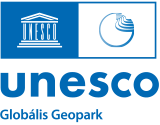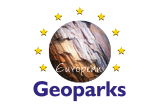Geosite of the Year in Bakony–Balaton UNESCO Global Geopark 2016
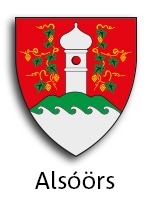
The label ‘Geosite of the Year’ was first given to a geosite by the Geopark organisation, the Balaton-felvidéki National Park Directorate in 2013. Since then the award has been presented annually to a new geosite and the associated local community. The award acknowledges the active role of these communities in protecting and promoting their local geological heritage by renewing an old nature trail or for example clearing a rock exposure of vegetation. In this way the geosite becomes more easily accessible and visible for residents and geotourists, and the community develops a stronger connection to its geoheritage. These activities are carried out by civil organizations and the local government, in cooperation with Balaton Uplands National Park Directorate, the leading organisation of the Geopark.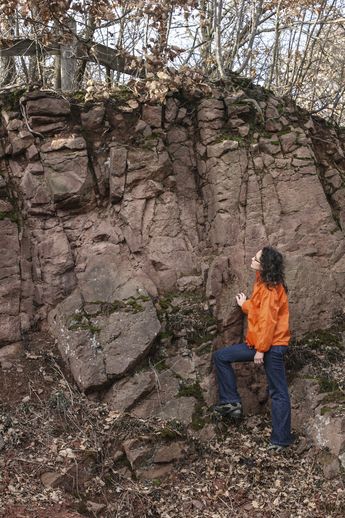
Alsóörs, a charming beach village on the Northern shore of Lake Balaton, has 1600 inhabitants. The village is surrounded by gentle slopes with vinyards and orchards. A fantastic view of the lake and sandy lidos await visitors. With the active support of the local government and experts of the Geopark’s leading organization, young and enthusiastic volunteers of the Pangea Association, a Geopark Partner, renewed the Red Stone Geological Trail in 2015–2016. Thanks to this successful cooperation, the local community received the award of ’Geosite of the Year in Bakony–Balaton Geopark’ in 2016. Several geo-programmes – guided geo-tours, a geo-activity day and a geopark contest – celebrated the award and promoted the geosite. Festivals, fairs, online platforms and a hiking map have proved to be indispensable tools for the Geopark to promote the results achieved by this cooperation.
The renovated trail is located in a disused stone quarry. Besides describing a typical rock type of the Geopark, the aproximately 260 million years old Permian red sandstone, panels connect the living and non-living natural heritage of the site, the history of local stone quarrying and processing, the architectural heritage of the village and – in the spirit of networking – other sandstone sites in UNESCO Global Geoparks.
The label ‘Geosite of the Year’ has been an effective tool to promote the geosites, the communities living nearby and the positive effects of cooperation, thus presenting a good example to other communities in the Geopark. The events for the promotion of the site as the “Geosite of the Year” organized by the Geopark and assisted by the members of the local community have strengthened the cooperation of these stakeholders.

Bakony–Balaton Geopark becomes UNESCO Global Geopark
Bakony–Balaton Geopark – founded by the Balaton-felvidéki National Park Directorate in 2006 – became member of the Global Geoparks Network (GGN) in 2012 and thus it became UNESCO Global Geopark in 2015 November.
The 195 Member States of UNESCO have ratified the creation of a new label, the UNESCO Global Geoparks, on 17 November 2015. This expresses governmental recognition of the importance of managing outstanding geological sites and landscapes in a holistic manner.
UNESCO Global Geoparks tell the 4,600 million year story of Planet Earth and of the geological events that shaped it as well as the evolution of humanity itself. Not only do they show evidence of past climate changes, they also inform local communities of present day challenges and help them prepare for 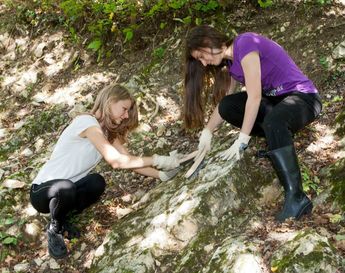 hazards such as earthquakes, tsunamis and volcanic eruptions.
hazards such as earthquakes, tsunamis and volcanic eruptions.
UNESCO Global Geoparks strive to raise awareness of geodiversity and promote protection, education and tourism best practices. Together with World Heritage sites and Biosphere Reserves, UNESCO Global Geoparks form a complete range of sustainable development tools and make an invaluable contribution to the realisation of the 2030 Sustainable Development Goals by combining global and local perspectives.
This new branding formalizes a relationship with Geoparks first established in 2001. Since then, Geoparks through the Global Geoparks Network have grown to include 120 sites all over the world. They have become an increasingly important tool for UNESCO to engage Member States and their communities in the Earth Sciences and geological heritage.
During the 38th session of UNESCO’s General Conference, Member States also decided to endorse the statutes of a new international programme: the International Geoscience and Geoparks Programme (IGGP). This allows the Organisation to more closely reflect the societal challenges of Earth Science today and provides an international status to a former network of sites of geological significance.
See more at the UNESCO Earth Sciences website
The "rebirth" of a geological key section
The road cutting on Zsidó Hill near Bakonynána village is one of the geological key sections in Hungary that have great importance.
The outcrop displays the "sharp boundary" between Late Cretaceous (developed cca. 100 million years ago) limestone and marl beds. The key section is located in Bakony–Balaton Geopark, in a very popular area among hikers: in the vicinity, the National Blue hiking route leads to the highly popular gorge and waterfall called Római-fürdő. Therefore, this geosite has a great potential of propagating its geology and the Geopark.
Thanks to the planned investment of VERGA Veszprém Forestry Ltd., this spectacular geosite is going to be "reborn" this year. The surface of the outcrop will be cleared; wooden seats, tables and a shelter will be set up. According to the plans, two panels will provide information about this abiotic natural asset and the world of Geoparks.
It is a great pleasure for us that our Geopark can cooperate with such outstanding partners! If you would like to see how this key section used to look like in the 80's and how it look likes today, click several times left or right from the dividing line in the middle of the photo (the green bar is not functioning yet, sorry, we are working to solve this).
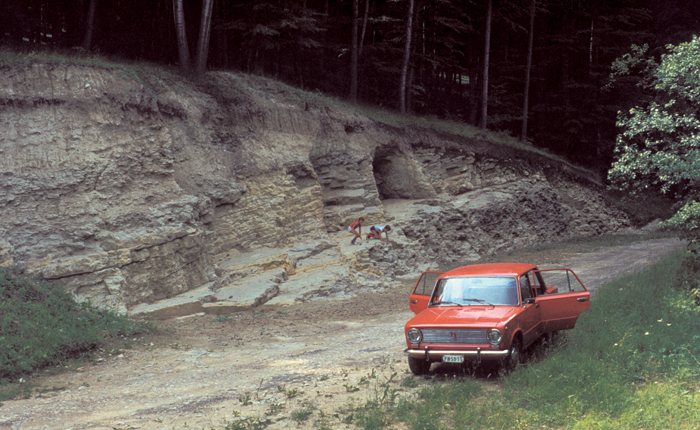

The leading organisation of the Bakony–Balaton Geopark, the Balaton Uplands National Park Directorate will provide substantial promotional help to inform people about this geological site and the investment. The ceremonial opening may take place during the European Geoparks Week during May–June 2015.
The geological key section is expected to become protected by law within reasonable time.
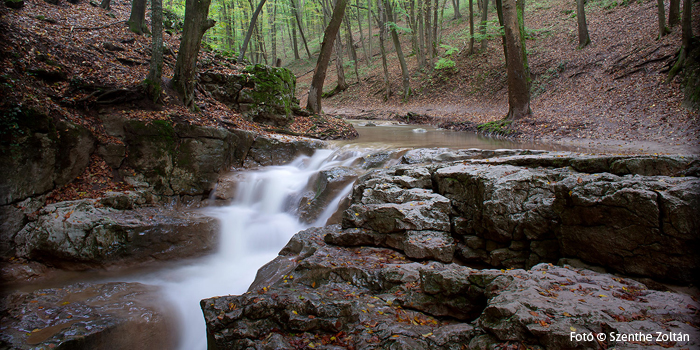
Római-fürdő, one of the most popular destinations for hikers in Bakony Hills can be found nearby.
New Visitor Centre Open at Lake Cave of Tapolca
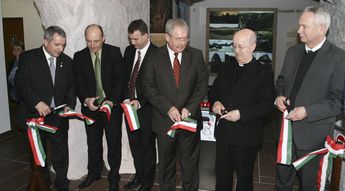 The Balaton Uplands National Park Directorate, the leading organisation of Bakony–Balaton Geopark held the opening ceremony of the Tapolca Lake Cave Visitor Centre on 20 January 2015.
The Balaton Uplands National Park Directorate, the leading organisation of Bakony–Balaton Geopark held the opening ceremony of the Tapolca Lake Cave Visitor Centre on 20 January 2015.
The internationally unique tourism facility will also function as the Western Gate of the Geopark. Before boating in the Lake Cave, visitors can enjoy the "Wonderful Karst" exhibition and 3 D film in the new building. More details about the visitor centre can be read in our previous article (see two articles below) and the website of the visitor centre.
The visitor centre was open by (from left to right) Zoltán Puskás director (Balaton Uplands National Park Directorate), Szabolcs Takács Administrative Government Commissioner (Veszprém County Government Office), András Dr. Rácz Deputy Secretary of State for Environment and Nature Protection (Ministry of Agriculture), Dr. Fazekas Sándor Minister (Ministry of Agriculture), Márfi Gyula archbishop, Polgárdy Imre chair (Veszprém County Council).
The (Hungarian and English language) leaflet of the new visitor centre can be downloaded from here.
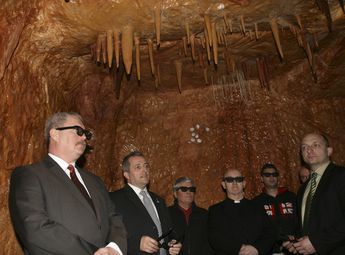
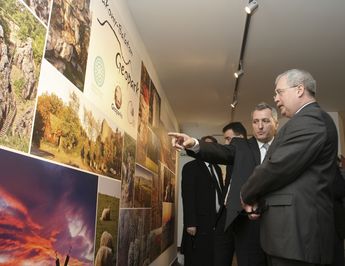
Geopark School Contest for students living in the Geopark
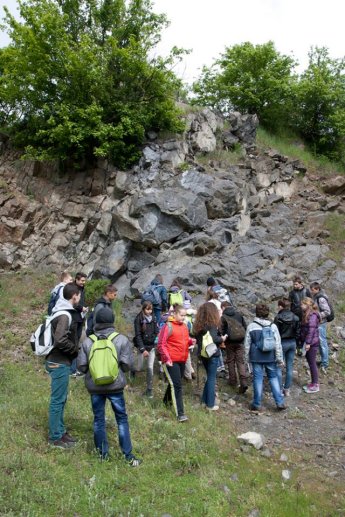 This year is the seventh occasion when the "Our Geopark" school contest is announced for students of the 7th and 8th grade of the elementary schools in Bakony–Balaton Geopark where 151 settlements can be found.
This year is the seventh occasion when the "Our Geopark" school contest is announced for students of the 7th and 8th grade of the elementary schools in Bakony–Balaton Geopark where 151 settlements can be found.
The purpose of the contest is to draw the students' attention to the especially rich geological heritage of the Geopark and to raise awareness regarding the importance of their protection. The contest also focuses on the biotic heritage of the region, especially the connections with abiotic natural heritage.
The students form groups of two and are mentored by an adult. They fill in two tests online and the 10 best groups participate in the final turn that will take place in the High Bakony Landscape Protection Area, the northern region of the Geopark.
The final includes a guided geotour where the students learn about the local natural heritage. The hiking tour is followed by a test and the presentations of the teams about a geological asset of the Geopark.
The contest is supported by the Pangea Association, a Bakony–Balaton Geopark Partner and by Herend Porcelain Manufactory Ltd.
The prizes of the contest include a 3-day long geotrip in the Geopark, entrance tickets to Szentgáli-kőlik Cave, Tapolca Lake Cave Visitor Centre, the Pannon Observatory, the Herend Porcelain Museum and participation of a guided geotour.







